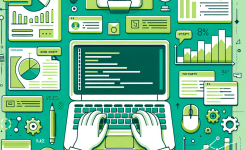Understanding the Gantt Chart
A Gantt chart is essentially a horizontal bar chart that illustrates a project schedule. Each bar represents a task or activity, and the length of the bar corresponds to the duration of the task. The chart typically includes a timeline along the horizontal axis and a list of tasks along the vertical axis. By visualizing tasks and their durations, project managers can quickly identify which tasks are on track, which are delayed, and how different tasks are interrelated. This clarity is invaluable for coordinating efforts and ensuring that the project stays on schedule.
The creation of a Gantt chart begins with a thorough understanding of the project scope and objectives. Project managers must first break down the project into smaller, manageable tasks, often referred to as a Work Breakdown Structure (WBS). Each task is then assigned a start and end date, along with any dependencies it may have on other tasks. This information is then plotted on the Gantt chart, providing a visual roadmap of the project. The chart not only helps in planning but also serves as a communication tool, allowing stakeholders to see the project's progress at a glance.
One of the key advantages of a Gantt chart is its ability to highlight task dependencies. In many projects, certain tasks cannot begin until others are completed. For example, in a construction project, the foundation must be laid before the walls can be erected. By clearly indicating these dependencies on the Gantt chart, project managers can avoid bottlenecks and ensure that tasks are completed in the correct sequence. This level of detail is crucial for maintaining the project's momentum and avoiding costly delays.
The Process of Creating a Gantt Chart
The process of creating a Gantt chart involves several steps, each of which requires careful consideration and planning. The first step is to define the project scope and objectives. This involves identifying the key deliverables and the tasks required to achieve them. Once the tasks have been identified, they need to be organized into a logical sequence, taking into account any dependencies between them. This sequence is then used to create the initial timeline for the project.
Next, the project manager must assign resources to each task. This includes identifying the team members responsible for each task, as well as any materials or equipment required. The availability of these resources can significantly impact the project timeline, so it is essential to factor this into the Gantt chart. Once the resources have been assigned, the project manager can begin to plot the tasks on the Gantt chart, using the timeline as a guide. The chart should be updated regularly to reflect the actual progress of the project, allowing for adjustments to be made as needed.
Finally, the Gantt chart should be shared with all relevant stakeholders. This includes team members, project sponsors, and any other individuals who have a vested interest in the project's success. By providing a clear, visual representation of the project's progress, the Gantt chart helps to ensure that everyone is on the same page. It also facilitates communication and collaboration, as team members can easily see how their tasks fit into the broader project timeline. Regular updates to the chart help to keep everyone informed and engaged, increasing the likelihood of project success.
Benefits of Using a Gantt Chart
One of the primary benefits of using a Gantt chart is its ability to provide a clear, visual representation of a project's timeline. This visual representation makes it easier for project managers and team members to understand the project's progress and identify any potential issues. By seeing the project's timeline at a glance, team members can quickly determine whether they are on track to meet their deadlines, and if not, what adjustments need to be made. This level of clarity is essential for maintaining the project's momentum and ensuring that it stays on schedule.
Another significant benefit of the Gantt chart is its ability to highlight task dependencies. As mentioned earlier, many projects involve tasks that are dependent on the completion of other tasks. By clearly indicating these dependencies on the Gantt chart, project managers can ensure that tasks are completed in the correct sequence, avoiding bottlenecks and delays. This level of detail is crucial for maintaining the project's flow and ensuring that all tasks are completed in a timely manner.

Finally, the Gantt chart serves as an excellent communication tool. By providing a visual representation of the project's progress, the Gantt chart helps to keep all stakeholders informed and engaged. This is particularly important in larger projects, where there may be multiple teams working on different aspects of the project. The Gantt chart ensures that everyone is aware of the project's status and can see how their tasks fit into the broader timeline. This level of transparency helps to foster collaboration and ensures that everyone is working towards the same goals.
Conclusion
In conclusion, the Gantt chart is an invaluable tool for project managers seeking to visualize and achieve their project goals. By providing a clear, visual representation of the project's timeline, tasks, and dependencies, the Gantt chart helps to ensure that projects stay on track and are completed on time. The process of creating a Gantt chart involves careful planning and consideration, but the benefits it provides far outweigh the effort required. From highlighting task dependencies to facilitating communication and collaboration, the Gantt chart is an essential tool for any project manager.
Moreover, the Gantt chart's ability to provide real-time updates on the project's progress makes it an indispensable tool for managing complex projects. By regularly updating the chart and sharing it with all relevant stakeholders, project managers can ensure that everyone is informed and engaged. This level of transparency and communication is crucial for maintaining the project's momentum and ensuring its success. Whether you are managing a small team or a large, multi-faceted project, the Gantt chart is a tool that can help you achieve your project goals.
In today's fast-paced and ever-changing business environment, the ability to visualize and manage project goals is more important than ever. The Gantt chart provides project managers with the tools they need to stay organized, communicate effectively, and ensure that their projects are completed on time and within budget. By mastering the art of Gantt chart production, project managers can set themselves up for success and achieve their project goals with confidence.
FAQ
1.What is the primary purpose of a Gantt chart?
The primary purpose of a Gantt chart is to provide a visual representation of a project's timeline, tasks, and dependencies. It helps project managers and team members track progress, identify potential issues, and ensure that tasks are completed in the correct sequence.
2.How do you create a Gantt chart?
Creating a Gantt chart involves several steps, including defining the project scope, breaking down the project into tasks, assigning resources, and plotting the tasks on a timeline. The chart should be updated regularly to reflect the actual progress of the project.
3.What are the benefits of using a Gantt chart?
The benefits of using a Gantt chart include providing a clear visual representation of the project timeline, highlighting task dependencies, and serving as an effective communication tool. It helps ensure that everyone is informed and engaged, increasing the likelihood of project success.
ARTICLE TITLE :Gantt chart production: how to visualize project goals ,AUTHOR :ITpmlib

















